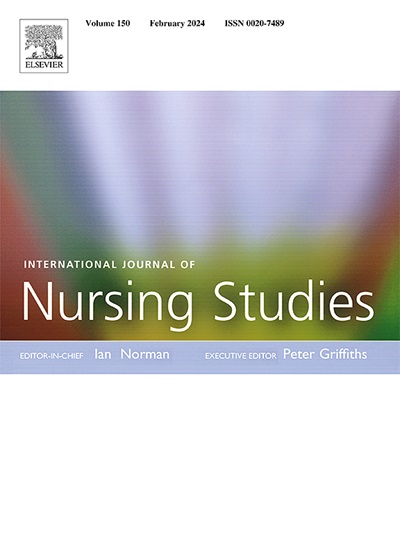Effects of virtual reality-based interventions on symptom management among adult patients in the intensive care unit: A systematic review and meta-analysis of randomized controlled trials
IF 7.1
1区 医学
Q1 NURSING
引用次数: 0
Abstract
Background
Critical illness and its management in the intensive care unit (ICU) place a significant burden on patients, leading to symptoms such as pain, sleep disorders, fatigue, dyspnea, thirst, anxiety, depression, and post-traumatic stress disorder. Virtual reality has emerged as a promising intervention for symptom management across various patient populations. However, the effects of virtual reality-based interventions on symptom management among adult ICU patients are unclear.
Aim
This review aims to critically synthesize evidence evaluating the effects of virtual reality-based interventions on symptoms in adult ICU patients.
Methods
A systematic search of PubMed, Embase, Web of Science, Cochrane Library, CINAHL, PsycINFO, CNKI, Wanfang Data, ProQuest Dissertations & Theses Global, ClinicalTrials.gov, and the Chinese Clinical Trial Registry (ChiCTR) from inception to 5 June 2025 was performed. The risk of bias was assessed using the revised Cochrane risk-of-bias tool for randomized trials. The effect of the intervention was estimated as the standard mean difference (SMD) with 95 % confidence interval (CI) using random-effects models in Review Manager 5.4, with heterogeneity assessed by the I2 statistic. Narrative syntheses were adopted when meta-analysis was inappropriate. The overall certainty of the evidence was rated using the Grading of Recommendations, Assessment, Development, and Evaluation (GRADE) approach. The protocol was registered in PROSPERO (ID: CRD42023487828).
Results
Out of 6517 identified records, 9 studies were eligible, and 8 were included in the meta-analysis. Virtual reality-based interventions significantly reduced anxiety levels (k = 6, SMD = − 0.50, 95 % CI [− 0.94, − 0.06], P = 0.02, I2 = 86 %, low certainty of evidence) and improve sleep quality in ICU patients (k = 4, SMD = 0.91, 95 % CI [0.62, 1.20], P < 0.00001, I2 = 32 %, low certainty of evidence). Exploratory subgroup analyses suggested a difference based on intervention frequency (P for subgroup difference = 0.04). Sensitivity analysis showed unstable results for anxiety but stable for sleep quality. Narrative analyses indicated that virtual reality-based interventions may reduce depression and short-term mental health-related quality of life but did not show significant effects on fatigue, thirst, dyspnea, post-traumatic stress disorder, or physical health-related quality of life. Effects on pain and overall discomfort were inconsistent. No severe adverse events were reported.
Conclusions
Preliminary evidence suggests that virtual reality-based interventions may alleviate anxiety, improve sleep quality, reduce depression, and enhance short-term mental health-related quality of life in adult ICU patients. Manageable safety concerns support their feasibility. Additional rigorous trials are needed to further confirm these findings.
基于虚拟现实的干预对重症监护病房成年患者症状管理的影响:随机对照试验的系统回顾和荟萃分析
重症监护病房(ICU)的危重疾病及其管理给患者带来了沉重的负担,导致疼痛、睡眠障碍、疲劳、呼吸困难、口渴、焦虑、抑郁和创伤后应激障碍等症状。虚拟现实已经成为一种有希望的干预措施,用于各种患者群体的症状管理。然而,基于虚拟现实的干预对成人ICU患者症状管理的影响尚不清楚。目的本综述旨在批判性地综合评价基于虚拟现实的干预对成人ICU患者症状的影响的证据。方法系统检索PubMed、Embase、Web of Science、Cochrane Library、CINAHL、PsycINFO、CNKI、万方数据、ProQuest Dissertations & &; Theses Global、ClinicalTrials.gov和中国临床试验注册中心(ChiCTR)自成立至2025年6月5日的数据库。使用改进的Cochrane随机试验偏倚风险工具评估偏倚风险。使用Review Manager 5.4中的随机效应模型,以95%置信区间(CI)的标准平均差(SMD)估计干预效果,并通过I2统计量评估异质性。当元分析不合适时,采用叙事综合。使用推荐、评估、发展和评价分级(GRADE)方法对证据的总体确定性进行评级。协议在PROSPERO中注册(ID: CRD42023487828)。结果在6517份确定的记录中,9项研究符合条件,8项纳入meta分析。基于虚拟现实的干预显著降低了ICU患者的焦虑水平(k = 6, SMD = - 0.50, 95% CI [- 0.94, - 0.06], P = 0.02, I2 = 86%,证据确定性低),改善了患者的睡眠质量(k = 4, SMD = 0.91, 95% CI [0.62, 1.20], P < 0.00001, I2 = 32%,证据确定性低)。探索性亚组分析显示基于干预频率的差异(亚组差异P = 0.04)。敏感性分析显示,焦虑的结果不稳定,但睡眠质量的结果稳定。叙述性分析表明,基于虚拟现实的干预可能会减少抑郁和短期与精神健康相关的生活质量,但对疲劳、口渴、呼吸困难、创伤后应激障碍或与身体健康相关的生活质量没有显着影响。对疼痛和整体不适的影响不一致。无严重不良事件报告。结论基于虚拟现实技术的干预可以缓解成人ICU患者的焦虑,改善睡眠质量,减少抑郁,提高短期心理健康相关生活质量。可管理的安全问题支持了它们的可行性。需要更多严格的试验来进一步证实这些发现。
本文章由计算机程序翻译,如有差异,请以英文原文为准。
求助全文
约1分钟内获得全文
求助全文
来源期刊
CiteScore
15.00
自引率
2.50%
发文量
181
审稿时长
21 days
期刊介绍:
The International Journal of Nursing Studies (IJNS) is a highly respected journal that has been publishing original peer-reviewed articles since 1963. It provides a forum for original research and scholarship about health care delivery, organisation, management, workforce, policy, and research methods relevant to nursing, midwifery, and other health related professions. The journal aims to support evidence informed policy and practice by publishing research, systematic and other scholarly reviews, critical discussion, and commentary of the highest standard. The IJNS is indexed in major databases including PubMed, Medline, Thomson Reuters - Science Citation Index, Scopus, Thomson Reuters - Social Science Citation Index, CINAHL, and the BNI (British Nursing Index).

 求助内容:
求助内容: 应助结果提醒方式:
应助结果提醒方式:


